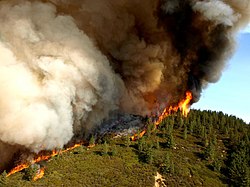Hazard
A hazard is something that can be dangerous to people, goods, and the environment.[1] Hazards are often marked with warning signs to help people know that a dangerous thing exists and to do the right thing to stay safe. Each hazard has ways to make it less dangerous or remove it.
For example, a motorist should read road signs and react to hazards on the road to stay safe like slowing down for sharp turns.
By Physical Nature
- Biological hazards are caused by living microorganisms (e.g., bacteria, viruses, and parasites) that can make other living things sick.[2]
- Chemical hazards are caused by harmful chemicals (e.g., acids).[3]
- Radioactive hazards are caused by materials that give off ionizing radiation (e.g., plutonium).
- Thermal hazards are caused by extreme heat (e.g., fires) or extreme cold (e.g., freezing weather).
- Kinetic hazards are caused by moving objects or forces (e.g., vehicles and loud vibrations).[4]
Hazard Media
A hazard pictogram to indicate a hazard from a flammable substance.
An active flame front of the Zaca Fire
GHS hazard pictograms for health hazards.
Hierarchy of hazard controls: Those hazard control methods at the top of the graphic are potentially more effective and protective than those at the bottom. Following this hierarchy of controls normally leads to the implementation of inherently safer systems, where the risk of illness or injury has been substantially reduced.
References
- ↑ Smith, Keith (1993). Environmental hazards: assessing risk and reducing disaster. Routledge physical environment series (Reprint ed.). London: Routledge. ISBN 978-0-415-01217-1.
- ↑ "Hazard definition & classification review". United Nations Office for Disaster Risk Reduction. 2022. Retrieved 19 May 2024.
- ↑ Jones, David (1992). Nomenclature for hazard and risk assessment in the process industries. Rugby, Warwickshire, UK: Institution of Chemical Engineers. ISBN 0-85295-297-X.
- ↑ https://www.britannica.com//science/kinetic-energy



